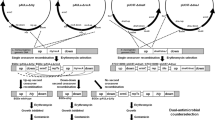Abstract
Genetic manipulation of multidrug-resistant bacteria is often difficult and hinders progress in understanding their physiology and pathogenesis. This book chapter highlights advances in genetic manipulation of Burkholderia cenocepacia, which are also applicable to other members of the Burkholderia cepacia complex and multidrug-resistant gram-negative bacteria of other genera. The method detailed here is based on the I-SceI homing endonuclease system, which can be efficiently used for chromosomal integration, deletion, and genetic replacement. This system creates markerless mutations and insertions without leaving a genetic scar and thus can be reused successively to generate multiple modifications in the same strain.
Access this chapter
Tax calculation will be finalised at checkout
Purchases are for personal use only
Similar content being viewed by others
References
Compant S, Nowak J, Coenye T, Clement C, Ait Barka E (2008) Diversity and occurrence of Burkholderia spp. in the natural environment. FEMS Microbiol Rev 32:607–626
Mahenthiralingam E, Baldwin A, Dowson CG (2008) Burkholderia cepacia complex bacteria: opportunistic pathogens with important natural biology. J Appl Microbiol 104:1539–1551
Vandamme P, Dawyndt P (2011) Classification and identification of the Burkholderia cepacia complex: past, present and future. Syst Appl Microbiol 34:87–95
Aaron SD, Ferris W, Henry DA, Speert DP, Macdonald NE (2000) Multiple combination bactericidal antibiotic testing for patients with cystic fibrosis infected with Burkholderia cepacia. Am J Respir Crit Care Med 161: 1206–1212
Nzula S, Vandamme P, Govan JR (2002) Influence of taxonomic status on the in vitro antimicrobial susceptibility of the Burkholderia cepacia complex. J Antimicrob Chemother 50: 265–269
Barrett AR, Kang Y, Inamasu KS, Son MS, Vukovich JM, Hoang TT (2008) Genetic tools for allelic replacement in Burkholderia species. Appl Environ Microbiol 74:4498–4508
Flannagan RS, Linn T, Valvano MA (2008) A system for the construction of targeted unmarked gene deletions in the genus Burkholderia. Environ Microbiol 10:1652–1660
Hamad MA, Zajdowicz SL, Holmes RK, Voskuil MI (2009) An allelic exchange system for compliant genetic manipulation of the select agents Burkholderia pseudomallei and Burkholderia mallei. Gene 430:123–131
Logue CA, Peak IR, Beacham IR (2009) Facile construction of unmarked deletion mutants in Burkholderia pseudomallei using sacB counter-selection in sucrose-resistant and sucrose-sensitive isolates. J Microbiol Methods 76: 320–323
Lopez CM, Rholl DA, Trunck LA, Schweizer HP (2009) Versatile dual-technology system for markerless allele replacement in Burkholderia pseudomallei. Appl Environ Microbiol 75: 6496–6503
Somprasong N, McMillan I, Karkhoff-Schweizer RR, Mongkolsuk S, Schweizer HP (2010) Methods for genetic manipulation of Burkholderia gladioli pathovar cocovenenans. BMC Res Notes 3:308
Monteilhet C, Perrin A, Thierry A, Colleaux L, Dujon B (1990) Purification and characterization of the in vitro activity of I-Sce I, a novel and highly specific endonuclease encoded by a group I intron. Nucleic Acids Res 18: 1407–1413
Aubert DF, O’Grady EP, Hamad MA, Sokol PA, Valvano MA (2013) The Burkholderia cenocepacia sensor kinase hybrid AtsR is a global regulator modulating quorum-sensing signalling. Environ Microbiol 15:372–385
Hamad MA, Di Lorenzo F, Molinaro A, Valvano MA (2012) Aminoarabinose is essential for lipopolysaccharide export and intrinsic antimicrobial peptide resistance in Burkholderia cenocepacia. Mol Microbiol 85:962–974
Khodai-Kalaki M, Aubert DF, Valvano MA (2013) Characterization of the AtsR phosphorelay pathway and identification of its response regulator in Burkholderia cenocepacia. J Biol Chem 288:30473–30484
Mahenthiralingam E, Coenye T, Chung JW, Speert DP, Govan JR, Taylor P, Vandamme P (2000) Diagnostically and experimentally useful panel of strains from the Burkholderia cepacia complex. J Clin Microbiol 38:910–913
Johnson WM, Tyler SD, Rozee KR (1994) Linkage analysis of geographic and clinical clusters in Pseudomonas cepacia infections by multilocus enzyme electrophoresis and riboty**. J Clin Microbiol 32:924–930
Hamad MA, Skeldon AM, Valvano MA (2010) Construction of aminoglycoside-sensitive Burkholderia cenocepacia strains for use in studies of intracellular bacteria with the gentamicin protection assay. Appl Environ Microbiol 76: 3170–3176
Figurski DH, Helinski DR (1979) Replication of an origin-containing derivative of plasmid RK2 dependent on a plasmid function provided in trans. Proc Natl Acad Sci U S A 76: 1648–1652
Rozen S, Skaletsky H (2000) Primer3 on the WWW for general users and for biologist programmers. Methods Mol Biol 132:365–386
Gay P, Le Coq D, Steinmetz M, Berkelman T, Kado CI (1985) Positive selection procedure for entrapment of insertion sequence elements in gram-negative bacteria. J Bacteriol 164: 918–921
Miller VL, Mekalanos JJ (1988) A novel suicide vector and its use in construction of insertion mutations: osmoregulation of outer membrane proteins and virulence determinants in Vibrio cholerae requires toxR. J Bacteriol 170: 2575–2583
Kolter R, Inuzuka M, Helinski DR (1978) Trans-complementation-dependent replication of a low molecular weight origin fragment from plasmid R6K. Cell 15:1199–1208
Cardona ST, Mueller CL, Valvano MA (2006) Identification of essential operons with a rhamnose-inducible promoter in Burkholderia cenocepacia. Appl Environ Microbiol 72: 2547–2555
Ortega XP, Cardona ST, Brown AR, Loutet SA, Flannagan RS, Campopiano DJ, Govan JR, Valvano MA (2007) A putative gene cluster for aminoarabinose biosynthesis is essential for Burkholderia cenocepacia viability. J Bacteriol 189:3639–3644
Acknowledgements
Research on Burkholderia cenocepacia was supported by grants from Cystic Fibrosis Canada, the Natural Sciences and Engineer Research Council of Canada, the UK Cystic Fibrosis Trust, and Marie Curie Career integration grant program to M.A.V. M.A.V. held a Canada Research Chair in Microbial Pathogenesis and Infectious Diseases.
Author information
Authors and Affiliations
Corresponding author
Editor information
Editors and Affiliations
Rights and permissions
Copyright information
© 2014 Springer Science+Business Media New York
About this protocol
Cite this protocol
Aubert, D.F., Hamad, M.A., Valvano, M.A. (2014). A Markerless Deletion Method for Genetic Manipulation of Burkholderia cenocepacia and Other Multidrug-Resistant Gram-Negative Bacteria. In: Vergunst, A., O'Callaghan, D. (eds) Host-Bacteria Interactions. Methods in Molecular Biology, vol 1197. Humana Press, New York, NY. https://doi.org/10.1007/978-1-4939-1261-2_18
Download citation
DOI: https://doi.org/10.1007/978-1-4939-1261-2_18
Published:
Publisher Name: Humana Press, New York, NY
Print ISBN: 978-1-4939-1260-5
Online ISBN: 978-1-4939-1261-2
eBook Packages: Springer Protocols




